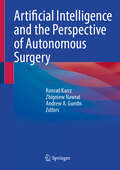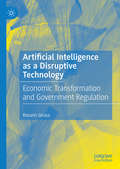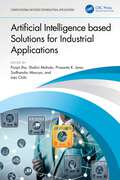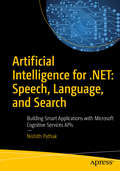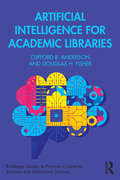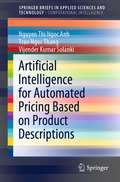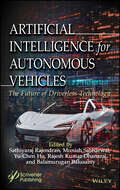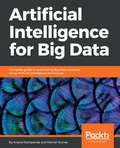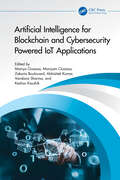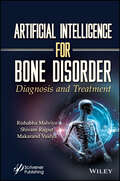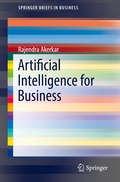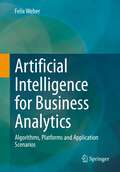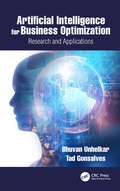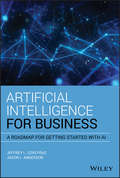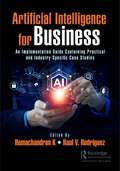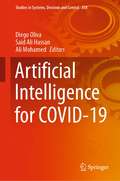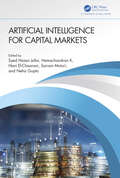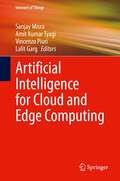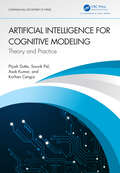- Table View
- List View
Artificial Intelligence and the New World Order: New weapons, New Wars and a New Balance of Power (Frontiers of Artificial Intelligence, Ethics and Multidisciplinary Applications)
by Fatima RoumateThis book discusses the implications of artificial intelligence (AI) on post-COVID-19 international relations. With the decline and fall of U.S. global leadership and the emergence of new powerful actors, as hastened by the global pandemic, new arms are now used in new forms of wars with new players. The balance of power swings between geostrategic interests and those linked to the global governance of virtual space and the race to technological sovereignty. Chapters focus on the challenges imposed by these changes on different parts of the international system—law, governance, diplomacy, international psychological security—and articulate new strategies and ethical policies as possible solutions. The volume is interdisciplinary and will appeal to researchers, students, and professionals across fields interested in the ethics of AI in the international system.
Artificial Intelligence and the Perspective of Autonomous Surgery
by Konrad Karcz Zbigniew Nawrat Andrew A. GumbsThis book has two heroes - the surgeon and the robot. The education system and intelligence can create a human who is specialized in surgery. While the accurate analysis of data with machine learning, AI, can create a more autonomous robot for surgery. Currently, robots still require human input in the decision-making loop, whether or not this will always be the case is an issue that still needs to be debated, analyzed and studied, preferably by computer scientists AND surgeons. Surgeons and their patients are increasingly opting for less invasive surgeries. However, among their many advantages, there is an important issue: less invasiveness always means limited access to direct information from the operating field (3D image, local palpation sensations, all information about the "whole" patient and feedback from the accompanying team during teleoperation). To increase precision, we are increasingly using surgical robots and mechatronic instruments. The less invasive the surgery and the greater the precision of robotic micro-instruments, the greater the role of artificial intelligence methods, especially machine learning, which supports the surgeon in making decisions, planning and performing the procedure. The development of artificial intelligence and further evidence of its effectiveness in various application fields mean that the work of a doctor is changing today. In the book, we address the issue of AI surgery, asking whether this means that an AI surgeon will be created? A key question about autonomous surgical robots will come up regularly: how far can we go with their autonomy while maintaining safe and effective procedures? The book provides useful information on both early successes, failures, and expectations related to the development of new technologies in surgery. It is a guide written by various experts, intended for a wide audience: from medical development planners, through students, to doctors and decision-makers.
Artificial Intelligence and the Two Singularities (Chapman & Hall/CRC Artificial Intelligence and Robotics Series)
by Calum ChaceThe science of AI was born a little over 60 years ago, but for most of that time its achievements were modest. In 2012 it experienced a big bang, when a branch of statistics called Machine Learning (and a sub-branch called Deep Learning) was applied to it. Now machines have surpassed humans in image recognition, and they are catching up with us at speech recognition and natural language processing. Every day, the media reports the launch of a new service, a new product, and a new demonstration powered by AI. When will it end? The surprising truth is, the AI revolution has only just begun. Artificial Intelligence and the Two Singularities argues that in the course of this century, the exponential growth in the capability of AI is likely to bring about two "singularities" - points at which conditions are so extreme that the normal rules break down. The first is the economic singularity, when machine skill reaches a level that renders many of us unemployable and requires an overhaul of our current economic and social systems. The second is the technological singularity, when machine intelligence reaches and then surpasses the cognitive abilities of an adult human, relegating us to the second smartest species on the planet. These singularities will present huge challenges, but this book argues that we can meet these challenges and overcome them. If we do, the rewards could be almost unimaginable. This book covers: • Recent developments in AI and its future potential • The economic singularity and the technological singularity in depth • The risks and opportunities presented by AI • What actions we should take Artificial intelligence can turn out to be the best thing ever to happen to humanity, making our future wonderful almost beyond imagination. But only if we address head-on the challenges that it will raise. Calum Chace is a best-selling author of fiction and non-fiction books and articles, focusing on the subject of artificial intelligence. He is a regular speaker on artificial intelligence and related technologies, and runs a blog on the subject at www.pandoras-brain. com. Prior to becoming a full-time writer and speaker, he spent 30 years in business as a marketer, a strategy consultant, and a CEO. He studied philosophy at Oxford University, where he discovered that the science fiction he had been reading since boyhood was simply philosophy in fancy dress.
Artificial Intelligence as a Disruptive Technology: Economic Transformation and Government Regulation
by Rosario GirasaArtificial intelligence (AI) is the latest technological evolution which is transforming the global economy and is a major part of the “Fourth Industrial Revolution.” This book covers the meaning, types, subfields and applications of AI, including U.S. governmental policies and regulations, ethical and privacy issues, particularly as they pertain and affect facial recognition programs and the Internet-of Things (IoT). There is a lengthy analysis of bias, AI’s effect on the current and future job market, and how AI precipitated fake news. In addition, the text covers basics of intellectual property rights and how AI will transform their protection. The author then moves on to explore international initiatives from the European Union, China’s New Generation Development Plan, other regional areas, and international conventions. The book concludes with a discussion of super intelligence and the question and applicability of consciousness in machines. The interdisciplinary scope of the text will appeal to any scholars, students and general readers interested in the effects of AI on our society, particularly in the fields of STS, economics, law and politics.
Artificial Intelligence based Solutions for Industrial Applications (Computational Methods for Industrial Applications)
by Prasanta K. Jana Sudhanshu Maurya Ines Chihi Pooja Jha Shalini MahatoArtificial Intelligence based Solutions for Industrial Applications aims to examine the utilization of artificial intelligence (AI) technologies to tackle difficult industrial issues and offers readers a thorough understanding of how these technologies are being employed to address intricate industrial challenges and to stimulate innovation. This book explores the fundamental principles of artificial intelligence (AI) and its practical use in industrial environments. This book improves understanding of core concepts, the present state of the art and real-time implementation of AI in many industrial applications. This book describes the detailed implementation of AI in the industrial sector as well as related case studies for in-depth understanding. Basic concepts, related work reviews, illustrations, empirical results, and tables are integrated within each chapter to give the readers the opportunity to gain maximum knowledge and to easily understand the methodology and results presented.This book introduces a variety of smart algorithms to help in filtering important information and to solve problems in the application domains. Application of machine learning and deep learning in the industry demonstrates the capabilities by which it may be used to solve practical problems in the 'Fourth Industrial Revolution', and it equips readers with the necessary knowledge and tools to design solutions by themselves with the help of theory and practical examples dealt with. The fourth industrial revolution and its consequences on society and organizations are discussed in this book.Features: Detailed understanding of the industrial application of AI. Discussion of core concepts of different machine learning and deep learning techniques such as artificial neural networks, support vector machines, K –nearest neighbour, decision tree, logistic regression, and many more. Detailed study on various industrial applications of machine learning and deep learning in healthcare, education, entertainment, share market, manufacturing, and many more. Case studies on industrial application of AI Summataion of the fourth industrial revolution and its consquences on society and organizations. This book is primarily written for graduate students, engineers, and academic researchers, industrial practitioners, and anyone who wants to optimize production processes, explore AI technology, or stay ahead in the industrial field. It covers the complexities of AI in industrial contexts from core basic understanding to complex implementation.
Artificial Intelligence for .NET: Building Smart Applications with Microsoft Cognitive Services APIs
by Nishith PathakGet introduced to the world of artificial intelligence with this accessible and practical guide. Build applications that make intelligent use of language and user interaction to better compete in today's marketplace. Discover how your application can deeply understand and interpret content on the web or a user's machine, intelligently react to direct user interaction through speech or text, or make smart recommendations on products or services that are tailored to each individual user. With Microsoft Cognitive Services, you can do all this and more utilizing a set of easy-to-use APIs that can be consumed on the desktop, web, or mobile devices. Developers normally think of AI implementation as a tough task involving writing complex algorithms. This book aims to remove the anxiety by creating a cognitive application with a few lines of code. There is a wide range of Cognitive Services APIs available. This book focuses on some of the most useful and powerful ways that your application can make intelligent use of language. Artificial Intelligence for . NET: Speech, Language, and Search will show you how you can start building amazing capabilities into your applications today. What You'll Learn Understand the underpinnings of artificial intelligence through practical examples and scenarios Get started building an AI-based application in Visual Studio Build a text-based conversational interface for direct user interaction Use the Cognitive Services Speech API to recognize and interpret speech Look at different models of language, including natural language processing, and how to apply them in your Visual Studio application Reuse Bing search capabilities to better understand a user's intention Work with recommendation engines and integrate them into your apps Who This Book Is For Developers working on a range of platforms, from . NET and Windows to mobile devices. Examples are given in C#. No prior experience with AI techniques or theory is required.
Artificial Intelligence for Academic Libraries (Routledge Guides to Practice in Libraries, Archives and Information Science)
by Clifford B. Anderson Douglas H. FisherArtificial Intelligence for Academic Libraries provides a clear and dependable guide to the history, theory, and application of artificial intelligence (AI) and machine learning (ML) in academic libraries, addressing the needs of librarians, staff, administrators, and other stakeholders. Emerging from a long-running conversation between an academic librarian and a professor of computer science, this book provides readers with a critical perspective on the history, present, and future of AI in libraries and information services. Synthesizing the literature on AI, ML, and librarianship, the authors provide the requisite background to evaluate the impact of these technologies on the information ecosystem. The first half of the volume covers the fundamentals of AI, notably the divergences between the two major AI paradigms as well as philosophical, legal, and ethical issues that arise from the use of AI. The second half addresses specialized topics, including hybrid AIs that bridge the dominant AI paradigms, the responsible use of AI in research and learning, and suggestions for professional development. Artificial Intelligence for Academic Libraries will benefit academic librarians seeking to develop a solid understanding of AI and ML and their likely impact on library operations and services, including student and faculty outreach. The volume also serves as a pedagogical resource for library and information science students entering this rapidly changing field.
Artificial Intelligence for Air Quality Monitoring and Prediction (AI Applications in Earth Science)
by Amit Awasthi Kanhu Charan Pattnayak Gaurav Dhiman Pushp Raj TiwariThis book is a comprehensive overview of advancements in artificial intelligence (AI) and how it can be applied in the field of air quality management. It explains the linkage between conventional approaches used in air quality monitoring and AI techniques such as data collection and preprocessing, deep learning, machine vision, natural language processing, and ensemble methods. The integration of climate models and AI enables readers to understand the relationship between air quality and climate change. Different case studies demonstrate the application of various air monitoring and prediction methodologies and their effectiveness in addressing real-world air quality challenges.Features A thorough coverage of air quality monitoring and prediction techniques. In-depth evaluation of cutting-edge AI techniques such as machine learning and deep learning. Diverse global perspectives and approaches in air quality monitoring and prediction. Practical insights and real-world case studies from different monitoring and prediction techniques. Future directions and emerging trends in AI-driven air quality monitoring. This is a great resource for professionals, researchers, and students interested in air quality management and control in the fields of environmental science and engineering, atmospheric science and meteorology, data science, and AI.
Artificial Intelligence for Art Creation and Understanding (Multimedia Computing, Communication and Intelligence)
by Luntian MouAI-Generated Content (AIGC) is a revolutionary engine for digital content generation. In the area of art, AI has achieved remarkable advancements. AI is capable of not only creating paintings or music comparable to human masterpieces, but it also understands and appreciates artwork. For professionals and amateurs, AI is an enabling tool and an opportunity to enjoy a new world of art.This book aims to present the state-of-the-art AI technologies for art creation, understanding, and evaluation. The contents include a survey on cross-modal generation of visual and auditory content, explainable AI and music, AI-enabled robotic theater for Chinese folk art, AI for ancient Chinese music restoration and reproduction, AI for brainwave opera, artistic text style transfer, data-driven automatic choreography, Human-AI collaborative sketching, personalized music recommendation and generation based on emotion and memory (MemoMusic), understanding music and emotion from the brain, music question answering, emotional quality evaluation for generated music, and AI for image aesthetic evaluation.The key features of the book are as follows: AI for Art is a fascinating cross-disciplinary field for the academic community as well as the public. Each chapter is an independent interesting topic, which provides an entry for corresponding readers. It presents SOTA AI technologies for art creation and understanding. The artistry and appreciation of the book is wide-ranging – for example, the combination of AI with traditional Chinese art. This book is dedicated to the international cross-disciplinary AI Art community: professors, students, researchers, and engineers from AI (machine learning, computer vision, multimedia computing, affective computing, robotics, etc.), art (painting, music, dance, fashion, design, etc.), cognitive science, and psychology. General audiences can also benefit from this book.
Artificial Intelligence for Automated Pricing Based on Product Descriptions (SpringerBriefs in Applied Sciences and Technology)
by Vijender Kumar Solanki Nguyen Thi Anh Tran Ngoc ThangThis book highlights artificial intelligence algorithms used in implementation of automated pricing. It presents the process for building automated pricing models from crawl data, preprocessed data to implement models, and their applications. The book also focuses on machine learning and deep learning methods for pricing, including from regression methods to hybrid and ensemble methods. The computational experiments are presented to illustrate the pricing processes and models.
Artificial Intelligence for Autonomous Networks (Chapman & Hall/CRC Artificial Intelligence and Robotics Series)
by Mazin GilbertArtificial Intelligence for Autonomous Networks introduces the autonomous network by juxtaposing two unique technologies and communities: Networking and AI. The book reviews the technologies behind AI and software-defined network/network function virtualization, highlighting the exciting opportunities to integrate those two worlds. Outlining the new frontiers for autonomous networks, this book highlights their impact and benefits to consumers and enterprise customers. It also explores the potential of the autonomous network for transforming network operation, cyber security, enterprise services, 5G and IoT, infrastructure monitoring and traffic optimization, and finally, customer experience and care. With contributions from leading experts, this book will provide an invaluable resource for network engineers, software engineers, artificial intelligence, and machine learning researchers.
Artificial Intelligence for Autonomous Vehicles: The Future of Driverless Technology (Advances in Data Engineering and Machine Learning)
by Yu-Chen Hu Balamurugan Balusamy Rajesh Kumar Dhanaraj Sathiyaraj Rajendran Munish SabharwalWith the advent of advanced technologies in AI, driverless vehicles have elevated curiosity among various sectors of society. The automotive industry is in a technological boom with autonomous vehicle concepts. Autonomous driving is one of the crucial application areas of Artificial Intelligence (AI). Autonomous vehicles are armed with sensors, radars, and cameras. This made driverless technology possible in many parts of the world. In short, our traditional vehicle driving may swing to driverless technology. Many researchers are trying to come out with novel AI algorithms that are capable of handling driverless technology. The current existing algorithms are not able to support and elevate the concept of autonomous vehicles. This addresses the necessity of novel methods and tools focused to design and develop frameworks for autonomous vehicles. There is a great demand for energy-efficient solutions for managing the data collected with the help of sensors. These operations are exclusively focused on non-traditional programming approaches and depend on machine learning techniques, which are part of AI. There are multiple issues that AI needs to resolve for us to achieve a reliable and safe driverless technology. The purpose of this book is to find effective solutions to make autonomous vehicles a reality, presenting their challenges and endeavors. The major contribution of this book is to provide a bundle of AI solutions for driverless technology that can offer a safe, clean, and more convenient riskless mode of transportation.
Artificial Intelligence for Big Data: Complete guide to automating Big Data solutions using Artificial Intelligence techniques
by Manish Kumar Anand DeshpandeBuild next-generation Artificial Intelligence systems with JavaKey FeaturesImplement AI techniques to build smart applications using Deeplearning4j Perform big data analytics to derive quality insights using Spark MLlibCreate self-learning systems using neural networks, NLP, and reinforcement learningBook DescriptionIn this age of big data, companies have larger amount of consumer data than ever before, far more than what the current technologies can ever hope to keep up with. However, Artificial Intelligence closes the gap by moving past human limitations in order to analyze data.With the help of Artificial Intelligence for big data, you will learn to use Machine Learning algorithms such as k-means, SVM, RBF, and regression to perform advanced data analysis. You will understand the current status of Machine and Deep Learning techniques to work on Genetic and Neuro-Fuzzy algorithms. In addition, you will explore how to develop Artificial Intelligence algorithms to learn from data, why they are necessary, and how they can help solve real-world problems.By the end of this book, you'll have learned how to implement various Artificial Intelligence algorithms for your big data systems and integrate them into your product offerings such as reinforcement learning, natural language processing, image recognition, genetic algorithms, and fuzzy logic systems.What you will learnManage Artificial Intelligence techniques for big data with JavaBuild smart systems to analyze data for enhanced customer experienceLearn to use Artificial Intelligence frameworks for big dataUnderstand complex problems with algorithms and Neuro-Fuzzy systemsDesign stratagems to leverage data using Machine Learning processApply Deep Learning techniques to prepare data for modelingConstruct models that learn from data using open source toolsAnalyze big data problems using scalable Machine Learning algorithmsWho this book is forThis book is for you if you are a data scientist, big data professional, or novice who has basic knowledge of big data and wish to get proficiency in Artificial Intelligence techniques for big data. Some competence in mathematics is an added advantage in the field of elementary linear algebra and calculus.
Artificial Intelligence for Blockchain and Cybersecurity Powered IoT Applications
by Abhishek Kumar Mariya Ouaissa Zakaria Boulouard Mariyam OuaissaThe objective of this book is to showcase recent solutions and discuss the opportunities that AI, blockchain, and even their combinations can present to solve the issue of Internet of Things (IoT) security. It delves into cuttingedge technologies and methodologies, illustrating how these innovations can fortify IoT ecosystems against security threats. The discussion includes a comprehensive analysis of AI techniques such as machine learning and deep learning, which can detect and respond to security breaches in real time. The role of blockchain in ensuring data integrity, transparency, and tamper- proof transactions is also thoroughly examined. Furthermore, this book will present solutions that will help analyze complex patterns in user data and ultimately improve productivity.
Artificial Intelligence for Bone Disorder: Diagnosis and Treatment
by Rishabha Malviya Shivam Rajput Makarand VaidyaARTIFICIAL INTELLIGENCE FOR BONE DISORDER The authors have produced an invaluable resource that connects the fields of AI and bone treatment by providing essential insights into the current state and future of AI in bone condition diagnosis and therapy, as well as a methodical examination of machine learning algorithms, deep learning approaches, and their real-world uses. The book explores the use of artificial intelligence (AI) in the diagnosis and treatment of various bone illnesses. The integration of AI approaches in the fields of orthopedics, radiography, tissue engineering, and other areas related to bone are discussed in detail. It covers tissue engineering methods for bone regeneration and investigates the use of AI tools in this area, emphasizing the value of deep learning and how to use AI in tissue engineering efficiently. The book also covers diagnostic and prognostic uses of AI in orthopedics, such as the diagnosis of disorders involving the hip and knee as well as prognoses for therapies. Chapters also look at MRI, trabecular biomechanical strength, and other methods for diagnosing osteoporosis. Other issues the book examines include several uses of AI in pediatric orthopedics, 3D modeling, digital X-ray radiogrammetry, convolutional neural networks for customized care, and digital tomography. With information on the most recent developments and potential future applications, each chapter of the book advances our understanding of how AI might be used to diagnose and treat bone problems. Audience This book will serve as a guide for orthopedic experts, biomedical engineers, faculty members, research scholars, IT specialists, healthcare workers, and hospital administrators.
Artificial Intelligence for Business (SpringerBriefs in Business)
by Rajendra AkerkarThis book offers a practical guide to artificial intelligence (AI) techniques that are used in business. The book does not focus on AI models and algorithms, but instead provides an overview of the most popular and frequently used models in business. This allows the book to easily explain AI paradigms and concepts for business students and executives. Artificial Intelligence for Business is divided into six chapters. Chapter 1 begins with a brief introduction to AI and describes its relationship with machine learning, data science and big data analytics. Chapter 2 presents core machine learning workflow and the most effective machine learning techniques. Chapter 3 deals with deep learning, a popular technique for developing AI applications. Chapter 4 introduces recommendation engines for business and covers how to use them to be more competitive. Chapter 5 features natural language processing (NLP) for sentiment analysis focused on emotions. With the help of sentiment analysis, businesses can understand their customers better to improve their experience, which will help the businesses change their market position. Chapter 6 states potential business prospects of AI and the benefits that companies can realize by implementing AI in their processes.
Artificial Intelligence for Business Analytics: Algorithms, Platforms and Application Scenarios
by Felix WeberWhile methods of artificial intelligence (AI) were until a few years ago exclusively a topic of scientific discussions, today they are increasingly finding their way into products of everyday life. At the same time, the amount of data produced and available is growing due to increasing digitalization, the integration of digital measurement and control systems, and automatic exchange between devices (Internet of Things). In the future, the use of business intelligence (BI) and a look into the past will no longer be sufficient for most companies.Instead, business analytics, i.e., predictive and predictive analyses and automated decisions, will be needed to stay competitive in the future. The use of growing amounts of data is a significant challenge and one of the most important areas of data analysis is represented by artificial intelligence methods.This book provides a concise introduction to the essential aspects of using artificial intelligence methods for business analytics, presents machine learning and the most important algorithms in a comprehensible form using the business analytics technology framework, and shows application scenarios from various industries. In addition, it provides the Business Analytics Model for Artificial Intelligence, a reference procedure model for structuring BA and AI projects in the company.This book is a translation of the original German 1st edition Künstliche Intelligenz für Business Analytics by Felix Weber, published by Springer Fachmedien Wiesbaden GmbH, part of Springer Nature in 2020. The translation was done with the help of artificial intelligence (machine translation by the service DeepL.com). A subsequent human revision was done primarily in terms of content, so that the book will read stylistically differently from a conventional translation. Springer Nature works continuously to further the development of tools for the production of books and on the related technologies to support the authors.
Artificial Intelligence for Business Optimization: Research and Applications
by Bhuvan Unhelkar Tad GonsalvesThis is primarily a business book that discusses the research and associated practical application of artificial intelligence (AI) and machine learning (ML) in order to achieve business optimization (BO). AI comprises a wide range of technologies, databases, algorithms, and devices. This book aims for a holistic approach to AI by focusing on developing business strategies that will not only automate but also optimize business functions, processes, and people’s behaviors. Artificial Intelligence for Business Optimization: Research and Applications explores AI and ML from a business viewpoint with the key purpose of enhancing customer value. It applies research methods and fundamentals from a practitioner’s viewpoint and incorporates discussions around risks and changes associated with the utilization of AI in business. Furthermore, governance risks, privacy, and security are also addressed in this book to ensure compliance with AI/ML applications. Readers should find direct and practical applications of the discussions in this book quite useful in their work environment. Researchers will find many ideas to further explore the applications of AI to business.
Artificial Intelligence for Business: A Roadmap for Getting Started with AI
by Jason L. Anderson Jeffrey L. CoveyducArtificial Intelligence for Business: A Roadmap for Getting Started with AI will provide the reader with an easy to understand roadmap for how to take an organization through the adoption of AI technology. It will first help with the identification of which business problems and opportunities are right for AI and how to prioritize them to maximize the likelihood of success. Specific methodologies are introduced to help with finding critical training data within an organization and how to fill data gaps if they exist. With data in hand, a scoped prototype can be built to limit risk and provide tangible value to the organization as a whole to justify further investment. Finally, a production level AI system can be developed with best practices to ensure quality with not only the application code, but also the AI models. Finally, with this particular AI adoption journey at an end, the authors will show that there is additional value to be gained by iterating on this AI adoption lifecycle and improving other parts of the organization.
Artificial Intelligence for Business: An Implementation Guide Containing Practical and Industry-Specific Case Studies
by Raul V. Rodriguez K HemachandranArtificial intelligence (AI) is transforming the business world at an unprecedented pace. From automating mundane tasks to predicting consumer behaviour, AI is changing the way businesses operate across all sectors. This book is an exploration of AI in business applications, highlighting the diverse range of ways in which AI is being used across different industries. The book begins with an overview of AI in business and its impact on the workforce. It then explores the role of AI in marketing, advertising, and tourism. The use of AI in personalized recommendations and chatbots is discussed in detail. The book then moves on to examine how AI is changing the retail industry, improving supply chain management, and enhancing the customer experience. The media and entertainment industry is also examined, with a focus on how AI is being used to personalize content and improve the user experience. The book also explores the use of AI in human resources, insurance, legal, and finance. The impact of AI on talent identification, recruitment, underwriting, document analysis, and financial forecasting is discussed in detail. In the healthcare and sports industries, AI is transforming the way we approach diagnosis, treatment, and training. The book examines how AI is being used to analyse medical images, develop personalized treatment plans, and improve patient outcomes. The use of AI in sports performance analysis is also discussed in detail. Finally, the book explores the use of AI in agriculture, energy, education, and the public sector. The potential of AI to optimize crop yields, reduce energy consumption, and improve the quality of education is discussed in detail. The book also examines how AI is being used to improve public services, such as transportation and emergency services. This book is a valuable resource for academics, researchers, professionals, and policymakers who are interested in understanding the potential of AI in the business world. The contributions from leading experts and researchers provide a comprehensive overview of AI in business applications, and how it is transforming different sectors. The book also examines the ethical dilemmas that arise from the use of AI in business, such as the impact on privacy and data security, and the potential for bias in AI algorithms. It provides valuable insights into how businesses can ensure that the use of AI is ethical and responsible. In conclusion, this book is a must-read for anyone interested in the potential of AI in the business world. It provides a comprehensive overview of AI in business applications and how it is transforming different sectors. The book examines the ethical dilemmas that arise from the use of AI in business, providing valuable insights into how businesses can ensure that the use of AI is ethical and responsible. We hope that readers will find this book informative and thought-provoking.
Artificial Intelligence for Business: Harness AI for Value, Growth and Innovation
by Kamales LardiUnderstand and harness the power of artificial intelligence to drive growth and innovation with this comprehensive guide. As AI continues to evolve, it is increasingly important for businesses to make informed decisions about how to use AI to drive success and growth. Artificial Intelligence for Business aims to provide a comprehensive understanding of AI and its applications in business, making it the ideal resource for business managers and leaders looking to stay ahead of the curve. With a focus on practical applications, it helps readers understand what AI is, how it is transforming business, how it can be used to innovate and how to navigate the realities of implementation. This book looks at the combination of AI with other emerging technologies such as blockchain, internet of things and virtual and augmented reality, showing how these can work together to create new business opportunities and solve complex business problems. It provides guidance on the importance of designing AI applications that are human-centred, including inclusive design and empathy in AI. It also features contributions and insights from leading experts and a wealth of real-world examples profiling AI adoption and innovation.
Artificial Intelligence for COVID-19 (Studies in Systems, Decision and Control #358)
by Diego Oliva Said Ali Hassan Ali MohamedThis book presents a compilation of the most recent implementation of artificial intelligence methods for solving different problems generated by the COVID-19. The problems addressed came from different fields and not only from medicine. The information contained in the book explores different areas of machine and deep learning, advanced image processing, computational intelligence, IoT, robotics and automation, optimization, mathematical modeling, neural networks, information technology, big data, data processing, data mining, and likewise. Moreover, the chapters include the theory and methodologies used to provide an overview of applying these tools to the useful contribution to help to face the emerging disaster. The book is primarily intended for researchers, decision makers, practitioners, and readers interested in these subject matters. The book is useful also as rich case studies and project proposals for postgraduate courses in those specializations.
Artificial Intelligence for Capital Markets
by Neha Gupta Syed Hasan Jafar K Hemachandran Hani El-Chaarani Sairam MoturiArtificial Intelligence for Capital Market throws light on the application of AI/ML techniques in the financial capital markets. This book discusses the challenges posed by the AI/ML techniques as these are prone to "black box" syndrome. The complexity of understanding the underlying dynamics for results generated by these methods is one of the major concerns which is highlighted in this book. Features: Showcases artificial intelligence in finance service industry Explains credit and risk analysis Elaborates on cryptocurrencies and blockchain technology Focuses on the optimal choice of asset pricing model Introduces testing of market efficiency and forecasting in the Indian stock market This book serves as a reference book for academicians, industry professionals, traders, finance managers and stock brokers. It may also be used as textbook for graduate level courses in financial services and financial analytics.
Artificial Intelligence for Cloud and Edge Computing (Internet of Things)
by Vincenzo Piuri Sanjay Misra Lalit Garg Amit Kumar TyagiThis book discusses the future possibilities of AI with cloud computing and edge computing. The main goal of this book is to conduct analyses, implementation and discussion of many tools (of artificial intelligence, machine learning and deep learning and cloud computing, fog computing, and edge computing including concepts of cyber security) for understanding integration of these technologies. With this book, readers can quickly get an overview of these emerging topics and get many ideas of the future of AI with cloud, edge, and in many other areas. Topics include machine and deep learning techniques for Internet of Things based cloud systems; security, privacy and trust issues in AI based cloud and IoT based cloud systems; AI for smart data storage in cloud-based IoT; blockchain based solutions for AI based cloud and IoT based cloud systems.This book is relevent to researchers, academics, students, and professionals.
Artificial Intelligence for Cognitive Modeling: Theory and Practice (Chapman & Hall/CRC Internet of Things)
by Souvik Pal Korhan Cengiz Pijush Dutta Asok KumarThis book is written in a clear and thorough way to cover both the traditional and modern uses of artificial intelligence and soft computing. It gives an in-depth look at mathematical models, algorithms, and real-world problems that are hard to solve in MATLAB. The book is intended to provide a broad and in-depth understanding of fuzzy logic controllers, genetic algorithms, neural networks, and hybrid techniques such as ANFIS and the GA-ANN model. Features: A detailed description of basic intelligent techniques (fuzzy logic, genetic algorithm and neural network using MATLAB) A detailed description of the hybrid intelligent technique called the adaptive fuzzy inference technique (ANFIS) Formulation of the nonlinear model like analysis of ANOVA and response surface methodology Variety of solved problems on ANOVA and RSM Case studies of above mentioned intelligent techniques on the different process control systems This book can be used as a handbook and a guide for students of all engineering disciplines, operational research areas, computer applications, and for various professionals who work in the optimization area.

